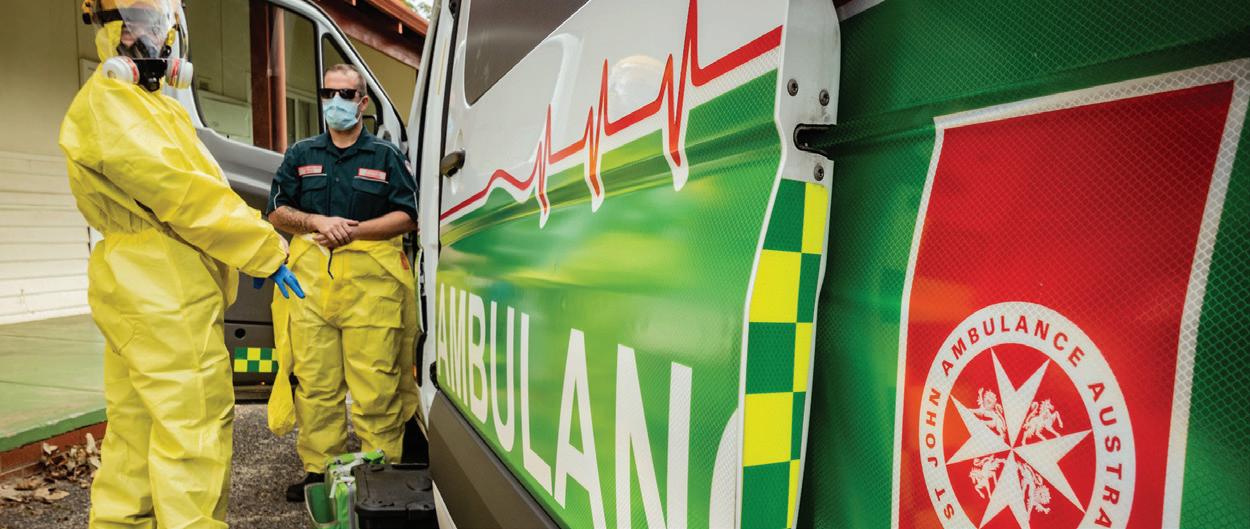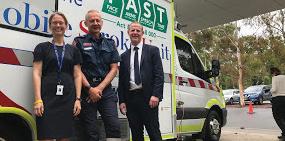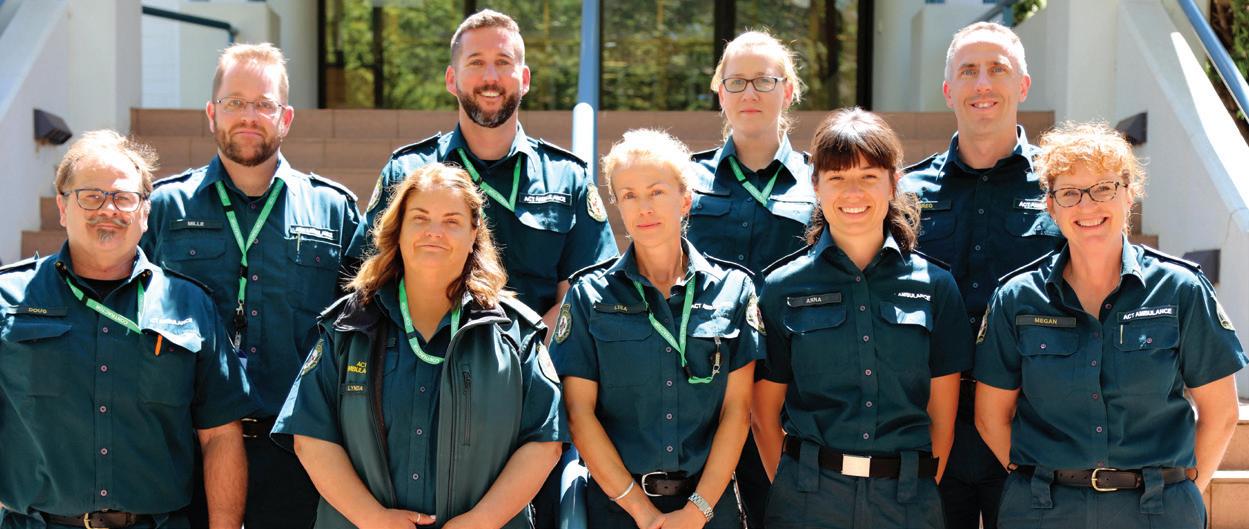
12 minute read
Excellence in Patient Care
Excellence in
Patient Care
This category is looking at patient experience improvement or innovation. Previous submissions looked at mental health responses, individual patient stories, community paramedicine, and assisting high frequency 000 callers. Each service is emboldened to examine ways that their organisation has assisting specific patient cohorts where learnings were of the benefit for the field of paramedicine.
Excellence in Patient Care Mental Health Co-Response - Improving patient experiences for Territorians
St John Ambulance Australia NT
Team: Nicole Johnston (team leader)
In a first for the Northern Territory, St John NT has joined with the Northern Territory Police (NTPOL) and Top End Mental Health and Alcohol and Other Drug Services (TEMHAODS) to provide a specialised response service to acute mental health crises in Darwin and the surrounding areas. The patient-centred model of targeted care commenced in October 2020 with acute mental health Triple Zero (000) calls responded to by the Co-Response Team; a mental health clinician, a police officer and a paramedic. The program operates Monday to Friday from midday to 8pm.
The specialist team includes four members of NTPOL, four trained paramedics from St John NT and two clinicians from TEMHAODS. The team is located at a Darwin Police Station, travels in an ambulance and calls to the service are taken and managed by St John NT in its Emergency Communication Centre (ECC). The multidisciplinary team undertook a training program facilitated predominantly by TEMHAODS and St John NT, with the inclusion of a number of mental health and support network stakeholders across Darwin.
The Co-Response program is an early-intervention approach aimed at reducing trauma and improving experiences for members of the community during an acute mental health episode and more broadly when accessing mental health services. By treating patients on scene in their own environment, the program aims to reduce mental health-related emergency department admissions. Treating patients in their own environment greatly improves the patient experience by:
• Allowing them to stay where they feel comfortable • Avoiding potentially unnecessary transport to hospital
• Avoiding hospital delays and restrictions of freedom (including avoidance of police custody) • Reducing potential triggers of hospital-related trauma. Interagency information sharing dramatically improves assessment and treatment options. It allows for the streamlining of healthcare pathways and improves timeframes for accessing mental health services. As a result, the program provides optimal patient care that is tailored and specific to the patient and their family. The early-intervention approach has the longterm aim of avoiding police custody, sectioning and restrictions of freedom for mental health patients, while helping to break the cycle of hospital, homelessness and jail.
Excellence in Patient Care SAAS Alternate Pathways of Care
SA Ambulance Service
Team: Kate Clarke (team leader)
Over the last three years, SAAS has played a central role in developing new care pathways for low acuity patients. SAAS established the Clinical Hub in 2018 in response to the pressures created by growing demand from these patients. Despite ever-increasing low acuity demand, the standard ambulance response had not changed significantly, with most patients transported to a hospital ED, mainly because of a lack of alternative options in the public health system.
The goal was to recalibrate the SAAS service delivery model to navigate more patients to alternate pathways of care, but first SAAS had to help design and develop those alternative pathways. In doing so, SAAS has established itself as a trusted clinical partner in the SA Health system. Over the last three years, the SAAS Clinical Hub has:
• Collaborated with other health services to design, develop and implement alternate pathways
• Integrated those pathways into the SAAS service delivery model
• Introduced Health Navigators to facilitate patient referrals to these pathways and support ambulance crews in navigating a variety of pathways • Established a Clinical Telephone Assessment service, using experienced paramedics to provide secondary triage and navigate more patients to alternate care pathways, ideally without involving emergency ambulance crews
The aim of the SAAS Clinical Hub was to increase the usage of alternate pathways of care for low to medium acuity patients, diverting them away from hospital emergency departments and navigating them to more appropriate care for their needs.
Excellence in Patient Care Secondary Triage Care Pathways Project
Ambulance Tasmania
Team: Samantha Allender (team leader)
Providing the Right Care in the Right Place at the Right Time The Secondary Triage Care Pathways Project was initiated in 2019 following a review of Ambulance Tasmania’s Clinical and Operational Services which found that “the utilisation of ambulance services has grown 14 times faster than Tasmania’s population,” with the caseload increasingly involving responding to unexpected primary health care needs.
Without rethinking, reform and introduction of a service delivery model to allow clinical assessment and prioritisation of patients presenting with low acuity symptoms, the emergency-focussed model would continue to direct patients towards services that exceed patient needs resulting “in inefficient utilisation of health resources” with the likelihood of poor patient experience “due to long wait times for both an ambulance, and treatment in an emergency department.” Secondary Triage went live on 22 February 2021 with approximately 25% of calls triaged by a Secondary Triage Clinician (STC) referred to alternate care pathways. Through the implementation of Secondary Triage, Ambulance Tasmania is striving to achieve excellence in patient care and improve our service, informed by the best available evidence and is already delivering excellence in patient care with significant plans for growth and expansion in coming months. The primary aim of the Project was to implement a Secondary Triage service that could safely provide clinical assessment to patients calling for low acuity conditions and ensure they could receive the right care, in the right place, and at the right time. Secondary Triage has a strong emphasis on improved patient experience and care through the provision of telephone clinical assessment to identify the best treatment pathway for the patient which may avoid ambulance attendance, transport and hospital admission. Other aims include:
• Ensuring patients receive the most appropriate care for their clinical presentation through the utilisation of alternate referral pathways.
• Providing a safety net for callers who are not initially identified as high acuity through primary triage processes.
• Management of frequent callers to Triple Zero using patient care plans to further improve the patient experience for this specific cohort.
• Increasing the availability of emergency ambulances to attend the highest acuity cases. • Building strong relationships with primary and community health services to support the reengagement of patients with the healthcare system. Improving public education / awareness surrounding the use of emergency ambulances to assist Tasmanians in better accessing and navigating the wider healthcare system and improving health literacy and self-advocacy.
Excellence in Patient Care Specialised Isolation Ambulances: Putting patients first during COVID-19
St John WA
Team: Nik Stewart (team leader) and Grant Ledger As Western Australia’s trusted provider of ambulance services, St John WA was required to develop innovative measures to mitigate the spread of COVID-19 during the transport and treatment of patients. The aim of the Specialised Isolation Ambulance (SIA) project was to create a dedicated fleet designed to support the care of COVID-19 patients, whilst minimising exposure risk to staff and preserving ambulance capability for community emergency response. A comprehensive audit of the patient care journey saw three key categories identified for innovation and improvement — personal protective equipment (PPE), staff training and vehicle modification. Working closely with industry and Government bodies such as the Public Health Emergency Operations Centre (PHEOC) and State Health Incident Coordination Centre (SHICC), St John WA introduced new measures that allowed continued service to the community both in metropolitan Perth, as well as rural and country WA.
Within weeks of the project being instigated by St John WA, the team had successfully trailed and developed a strategic implementation plan for SIAs in metropolitan and regional areas, including enhanced training of staff to deliver patient care to COVID-19 patients with these resources. With growing concern about potential spread of COVID-19 during early 2020, WA needed to prepare for potential pandemic impact. For St John WA, this meant safeguarding the patients, community and the workforce. As Western Australia’s trusted provider of ambulance services, St John WA needed to develop new innovative measures that would stop the spread in high-risk scenarios — such as the transport of COVID-19 patients.
The aim of this project was to create a dedicated fleet of specialised isolation ambulances to support care and transport of COVID-19 patients. Implementation of this capability enabled preservation of ambulance resources for community emergency response and reduced risk of exposure to staff and the broader community.
The project needed to be able to be implemented at scale. St John WA covers the largest area of any single ambulance service in the world: 2,525,500 km squared, 33 percent of the total landmass of Australia. The changes implemented through this project needed to facilitate remote and country St John WA teams to deliver the same level of care for COVID-19 patients that they would in the Perth metropolitan area.

Excellence in Patient Care Melbourne Mobile Stroke Unit
Ambulance Victoria
Team: Michael Stephenson (team leader), Shane Foster, Lindsay Bent, Peter Norbury, Dr Henry Zhao, Francesca Langenberg, Skye Coote, Dr Damian Easton, Prof Stephen Davis and Prof Geoffrey Donnan
Stroke is the second leading cause of death and a leading cause of disability worldwide yet, only one third of patients reach hospital in time for critical stroke treatment in Australia. Reducing the timeframe from the onset of stroke symptoms to the delivery of definitive treatment is crucial to reduce both mortality and disability. The Melbourne Mobile Stroke Unit (MSU) is Australia’s first pre-hospital road stroke service, starting in November 2017. The Melbourne MSU is a specialised, fully-equipped Ambulance Victoria vehicle, complete with a built-in CT scanner and on-board acute stroke personnel, dedicated to providing specialised prehospital care to acute stroke patients (both ischaemic and intracerebral haemorrhage). It is staffed by an ambulance paramedic, MICA paramedic, advanced practice stroke nurse, radiographer and a neurologist. The MSU operates Monday-Friday from 8am-6pm and is dual dispatched with a standard ambulance to acute stroke calls within a 20-km radius of the Royal Melbourne Hospital (RMH). The MSU is also able to respond to requests from paramedic crews outside of this radius. Receiving an average of 6-7 calls per day, our geographical catchment allows the MSU to attend to approximately 37% of the daily code stroke ambulance calls.
The MSU aims to improve pre-hospital stroke assessment and diagnosis, reduce the time to treatment for eligible patients, improve access to comprehensive stroke centres or neurosurgical centres and provide a unique platform for world class prehospital acute stroke clinical trials.

Excellence in Patient Care Police Ambulance Clinician Early Response (PACER)
ACT Ambulance Service
Team: Megan Davis (team leader) Mental health crisis experienced by ACT residents is rising. To explore ways to better address this issue, a tri-service health, ambulance, and policing project team was formed. Their initial mandate was to research domestic and international best practice in this regard. They explored various models, all with varying degrees of success. This research was then contextualised to the ACT, where a view on a path forward was agreed. Titled PACER (Police, Ambulance & Clinician Early Response), the project mandate was to develop a mental health coresponse capability. The first tranche (Proof-of-Concept) saw the training and embedding of mental health clinicians, paramedics, and police officers into a single response team. This team would respond to and manage acute mental health related incidents within the ACT community. Data from the proof-of-concept proved the viability of the capability and resultant positive patient outcomes. This was achieved by being able to keep most patients experiencing a mental health issue safely in the community. Consequently, the ACT Government has committed to sustaining the capability into the future. The PACER project has three primary objectives. Firstly, and most importantly, improve health outcomes and maintain the dignity for people experiencing a mental health episode. This will be achieved by utilising a health platform to deliver acute mental health services to the community. The second objective is to provide the least restrictive care, by reducing the use of restrictive measures such as emergency apprehension provisions under the ACT Mental Health Act 2015. Enabling clinical judgements earlier in the treatment cycle will result in many patients managing to safely remain within the community without transport to a hospital emergency department.
The third objective is to reduce demand on police, ambulance and emergency departments, along with acute inpatient services. This will be achieved by providing mental health assessment, treatment, care, and support through a dedicated capability within the community. Achieving these objectives expected to see a reduction in demand on frontline services of police, ambulance and health emergency services. Consequently, the number of emergency apprehension orders issued by ACT Policing and the ACT Ambulance Service would reduce. The secondary effect is an increase in the number of patients being able to remain safely in their own home with consequent positive patient outcomes.


Excellence in Patient Care TelePROMPT
Ambulance Victoria
CATEGORY WINNER
Team: Nicola Reinders (team leader), Brittany Dyson and Diana Zimmermann
Ambulance Victoria (AV) is leading innovation to improve the experience and outcomes for people experiencing mental health emergencies. Telehealth Prehospital Response of Mental health and Paramedic Team (TelePROMPT) is a pre-hospital response partnering on-scene paramedics with a mental health clinician through telehealth, accessing state-wide mental health records for rapid specialist mental health assessment and triage of patients. After assessing the patient, on scene paramedics can use telehealth technology to rapidly connect to a TelePROMPT mental health clinician from Eastern Health co-located with AV’s Triage Services. The mental health clinician has access to numerous information systems, including relevant mental health records. This enables us to understand the patient’s mental health care needs and options for referral. Where appropriate, the patient will be referred to alternative services that best meet their care needs, rather than transported to an emergency department, which is often not the best place for their care. TelePROMPT was designed through AV’s new Patient Care Academy, which brings together consumer, clinician, and system perspectives, to redesign care pathways for a Best Care experience that is high quality, patient-centred and safe. An agile, human-centred and co-design methodology focused on the needs and expectations of consumers, clinicians, and health care system. TelePROMPT aims to better connect mental health consumers to the right care, at the right time to improve their healthcare experience and outcomes. Benefits are also realised by upskilling paramedics as they work closely with mental health clinicians and also by hospital emergency departments through a reduction in demand pressures, particularly as mental health patient numbers have surged during the COVID-19 pandemic. TelePROMPT builds upon the PROMPT model, where mental health patients in the Barwon region received face-to-face care from a paramedic and a mental health practitioner. Instead of a mental health clinician physically travelling with a paramedic, paramedics on scene with a patient now have the option to contact a mental health clinician located in AV’s Triage Services who can access to the patient’s mental health record where available. Together, they will perform an enhanced rapid mental health assessment of the patient and decide on the most appropriate care option.
Of the ~590,000 calls to Triple Zero (000) for an ambulance emergency, around 71,000 (12%) were for mental health conditions.







